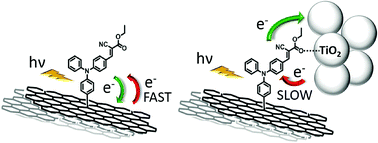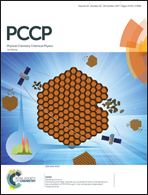Probing photoinduced electron-transfer in graphene–dye hybrid materials for DSSC†
Abstract
We investigated the photophysical properties of a newly synthesized hybrid material composed of a triphenylamine dye covalently bound to reduced graphene oxide, potentially relevant as a stable photosensitizer in dye-sensitized solar cells. The photophysical characterization has been carried out by means of fluorescence quenching and fluorescence lifetime measurements, complemented by Electron Paramagnetic Resonance (EPR) spectroscopy, aimed at the detailed description of the photoinduced processes occurring in the hybrid and in the mixed hybrid/N-doped TiO2 material. The combined optical/magnetic study unequivocally demonstrates a fast quenching of the dye excited state in the isolated hybrid and an efficient electron transfer to N-doped titania nanopowders. In the latter case, a metastable radical cation on the dye moiety is photogenerated and the corresponding negative charge, an electron, is trapped in defect sites of the doped semiconductor oxide. The spin distribution in the stable radical has been determined by EPR spectroscopy and correlated with DFT calculations.



 Please wait while we load your content...
Please wait while we load your content...